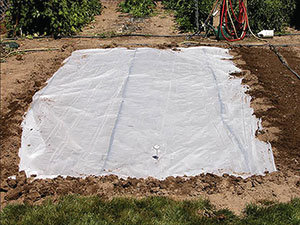- Steve Bogash, Vegetable Crop Advisor
Are you growing more intensively, but soil-borne diseases seem to keep getting ahead of you? If the answer to this question is “yes”, please read on. Diseases, insects, nematodes and other pests have many methods of finding their way into your soils. Sometimes the plants or media on transplants is infected, some fungal and bacterial spores are wind and water borne and we can carry the spores on our clothing and tools. We’ve got a great number of tools and techniques to deal with soil-borne diseases. Among these are disease resistant varieties, rotation within your garden, sanitation, drip irrigation, biological inoculants, and soil solarization.
The varieties of vegetables we use today are resistant to many diseases. Be sure to do the research before you order seeds or plants. Most seed catalogs will indicate wich varieties are resistant to what diseases. To get the most out of crop rotations, plan several years ahead and try to keep high value plants like solanaceous crops (tomatoes, peppers, eggplant, and potatoes) out of an area for at least 3 years.
 It’s often best to remove all crop residue after harvest and compost that material before reapplying it to your soil. Composting can kill most disease-causing organisms and insects. Never compost obviously diseased plant parts as heat required for this kind of cleanup is difficult to reach unless the entire composting system is well managed. Instead, burn it when conditions are safe.
It’s often best to remove all crop residue after harvest and compost that material before reapplying it to your soil. Composting can kill most disease-causing organisms and insects. Never compost obviously diseased plant parts as heat required for this kind of cleanup is difficult to reach unless the entire composting system is well managed. Instead, burn it when conditions are safe.
Drip irrigation is more efficient then overhead watering, and it reduces diseases by keeping roots uniformly moist and the leaves dry. The downside of drip is that swimming spores such as phytopthora can spread in the thin film of water within the soil or along drip lines.
When you’ve done everything right and problems persist, you can either quit that patch of ground and leave it allow for many years, or try some sort of fumigation or solarization. When southern Blight (sclerotium rolfsii) found its way into several of the Penn State high tunnels, we tried mustards, then went with steam from a coal fired steam tractor. Soil steaming is highly effective, but the necessary equipment may not be readily available. Soil solarization uses radient heat from the sun to “cook” the soil free of insects, disease causing organisms, and reduce many weeds.
Here is the “cookbook method” to soil solarization:
Step one: This technique works best during the long hot days of summer and requires at least several weeks to be effective. Longer periods will reduce more problmes. High tunnel and greenhouse soils may be able to begin the process earlier or later due to the longer season indoors.
Step two: Work your ground well to 8” deep and remove or break up all clumps and large pieces of organic matter. Sunflower and corn root crowns do not break down well and can reduce the effect of solarization. If you suspect a hard-pan or are trying to improve overall percolation, consider ripping with a subsoil shank prior to this treatment.
Step three: Apply enough water to the prepared ground to thoroughly wet the soil to 8”. This may take several applications if the ground is very dry as you do not want to make surface mud. Installing a drip irrigation manifold and tape over the area to be treated will allow for easy rewetting for the maximum effect.
Step four: Cover the ground with a thin layer of clear plastic and bury the edges completely. The clear plastic allows the sunlight to heat the ground beneath while trapping much of the heat generated. This is the greenhouse effect in action. Do not use black plastic as it only gets hot on the surface of the plastic as it will prevent trapping the suns long heat rays under the plastic.
Step five: Leave the cover in place for at least four weeks, longer is better. If you are curious about the heat generated, place a soil or compost thermometer through the plastic and 6” deep. Purslane seems to be the only weed that can survive this treatment. If purslane gets going under the plastic, remove the cover, treat the purslane and replace.
After removing the cover begin or resume practicing good crop rotations variety selection, and sanitation. If legumes (beans and peas) are your target crop, be sure to reinoculated the soil with the right Rhizobium bacteria as solarization will kill off most of this beneficial nitrogen fixing bacteria. After any treatment that impacts the entire rhizosphere (plant root zone), it is a good idea to reintroduce beneficials’ and ReStore 3G to your soil. An application of Terra Grow + ReStore 3G is the gold standard in reestablishing a good soil biome. Solarization can be an excellent method to rid your soil of really tough problems. The best part is that the hard work is done by the sun and no chemicals need to be applied. There is an excellent article on soil solarization online at http://ipm.ucanr.edu/PMG/PESTNOTES/pn74145.html.
